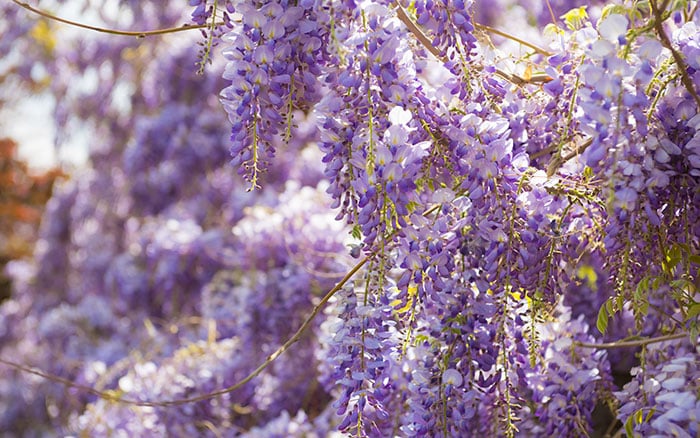To transform your garden with scent, flowers and foliage, it is impossible to beat wonderful wisteria and fabulous fuchsia
One is a stunning twining climber with highly scented flowers in blue, purple and white. The other is a bush-like shrub with pink and white pendant flowers that will bring bees flocking to your garden over summer. Wisteria and fuchsia are two of my favourites. They are guaranteed to transform your garden and home with vivid colours, incredible scent and generous foliage. And it’s hard to go anywhere in the UK at the moment without spotting a glorious wisteria in full flower. Once you’ve seen your first, they are impossible to miss for they herald spring like little else. Plus, there is something fundamentally British about them. They are a truly classy plant.

They are ideal for covering pergolas, walls, fences and sheds. They will also look magnificent trained up the side of a terraced house or the grandest country home. Scented pendants of luscious flowers drape from woody branches in a breathtaking display, flowering any time from April until late June, depending on the weather.
Wisteria will run rampant without proper management

Get them into the ground in spring or autumn for best results. They will even thrive in a large container if you have a small garden. They will prosper best in a sunny spot in the garden in well-drained soil and should be flowering within four years of planting. Two of the most popular varieties in Britain are Wisteria floribunda (Japanese wisteria) and Wisteria sinensis (Chinese wisteria). Both species are hardy and fast-growing and should eventually reach 25 to 30ft against a wall with a decent spread. But without proper management, wisteria will run rampant, producing masses of leaves. As a result, the plant can expend energy on foliage and all but forget about its flowers.
To control that growth and allow for more vitality to get into its flowers, you will need to prune between February and March, when the plant is dormant. While it is without leaves, you will also find it easier to make a judgment on where to prune. Leave just two sets of buds on each branch to give your plant the best start once the weather warms up. Then prune again after flowering, some time during early summer.
Come July, most flowers should have dropped off. Tie any major structural branches back to the supporting trellis or wires. Use these branches to fill in gaps in the overall structure of the plant to make it look tidier. Keep it fertilised with a high-potash feed to allow the flowering strength to build up for next season.
Fab Fuchsias
Fuchsias are equally magnificent and their flowers will take you through from mid-summer into the autumn. We enjoy them in hanging baskets, pots and containers. There are many hardy perennials that will faithfully return to your borders every year. They are a huge favourite in parks and are loved for their vibrant colours. No wonder there’s a shade of pink named after them. Their beautiful flowers open back to florets with long, graceful stamen. They hang like clusters of church bells.
Family Favourite
My father grew Fuchsia ‘Riccartonii’ and we all enjoyed its annual appearance in the garden, year after year. The buds enclose the flowers like a painter’s brush dipped in water. Fuchsia comes in an amazing variety of colours, shapes and sizes – some flowering as big as your palm, with others as small as your fingernail. Plant them in full sun or partial shade in fertile, well-drained soil. Bush fuchsias usually come in a 13cm pot for about a fiver. They are ideal for pots or containers or as centrepieces in hanging baskets. Treat them as a summer plant and take them inside when the frost comes. If not, the frosts will burn them off.

In the same category, there’s the trailing fuchsia. These have a natural weeping habit. The standard fuchsia is like a little tree, with a head shaped like a lollipop. A couple of them planted in containers either side of the front door looks stunning. The final category in this lovely bunch is hardy fuchsias. Plant them in a border and they will come up every year. They are not always as spectacular in flowering but varieties such as Mrs Popple, Tom Thumb and David are terrific. With any fuchsia, make sure it is well-watered and keep a close eye out for pests like whitefly and vine weevil. Liquid fertilisers, such as Miracle Gro, are great boosters and regular feeding will help deliver even more dramatic results.

Leave A Comment